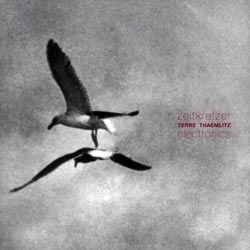
Founded by Reinhold Freidl, Zeitkratzer is an eleven-piece ensemble using acoustic instruments to reinterpret music made by electronics. If it were only that simple. Further compounding such fundamental ideals, the collective chose to "collaborate" with autodidactic sonic theorist and transformational desirist Terre Thaemlitz, whose struggle to dispense with societal absolutes like gender identity and the (non)applications of sexual politics vis-เ-vis music (specifically, electronic music) seem wholly at odds with Zeitkratzer's stark acoustic approaches. In fact, this meeting of the ideals, as it were, promotes an argument that opposites do in fact attract. Even more so, the very nature of what Zeitkratzer do revisiting contexts of a resolutely electronic background and redefining, ne้ vanquishing the lines separating what connotes "acoustic" and "electronic" becomes preternaturally synergistic with Thaemlitz's singular modes of articulation.
Thaemlitz is a controversial figure no doubt, his music often subversive in its genre-specific designations, working within but pushing against the membranes of ill-defined categorical rubrics such as "ambient", "house" and "techno." His experiments in highly stylized "academic" computer music, worthy successors in their own right to the mantles occupied by Cage, Xenakis, Stockhausen and their ilk, are nevertheless diametric opposites (even apposite) to the rust(y)belt avant-garde traditions that those aforementioned artists sought as well to distance themselves from. Zeitkratzer also seem to seek some way out of stodgy, terribly outmoded, "classical" idioms that long outlived their usefulness: they also seek to wreck the model from deep inside the corpus, blurring scenarios, upsetting equilibriums and manners, square pegs in round holes working frantically to wipe out the very contours of the new shapes they're originating.
The six works here do indeed obfuscate boundaries, trash demarcation points, make hazy lines drawn between acoustic tones and electronic tonalities. Whether or not Thaemlitz's ambitions are realized wholecloth is open to interpretation itself what remains is the ephemeral as well as the tactile nature of the sounds themselves, and in that regard the music is as involving as it seeks to be. "Down Home Kami-Sakunobe" is a sturdy attempt at an analog (both aesthetically and literally) of Thaemlitz's "dance" piece, the propulsive rhythms and thickening horn/string amalgams disarming at first, but it's difficult not to find yourself completely enthralled with the track's sheer audacity, acoustic warts and all, sans circuitry. There is little if anything electronic throughout this entire recording, other than the odd picadillo or timbral smear, but that effect in itself is illusionary; contrary to the booklet's credits, much of the music feels stripped of its acoustic moorings and thrust into a digital mainframe. A piece such as "Hobo Train" uses repeating piano notes as a form of rudimentary sequencer, achieving much of the same propulsive results. Of course, the kicker lies in the album's finale, "Superbonus", which erects a series of windblown drones atop tightly wound strings that, well, rip Thaemlitz's compositional physics asunder as much as complement them. Post-modernism, post-classical, post-whatever all such contemporary reinterpretations should be so empathetic and mimetic.
Comments and Feedback:



More Recent Reviews, Articles, and Interviews @ The Squid's Ear...


|

